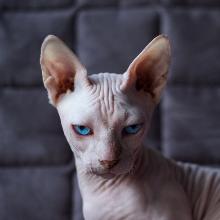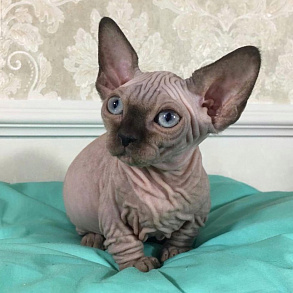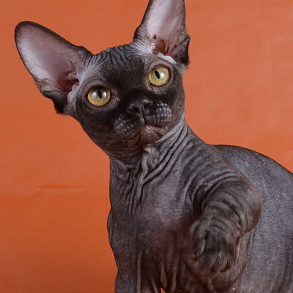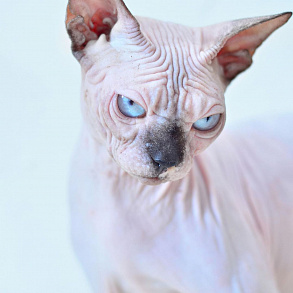Bambino

Bambino is a designer hybrid of the Canadian sphinx and munchkin, presented to the world in 2005. The identifying features of the breed representatives are short paws, a smooth, almost hairless body, huge ears.
Brief information
- Breed Name: Bambino
- Country of Origin: USA
- Weight: 2-4 kg
Highlights
- The name "bambino" comes from the Italian bambino, which means "child".
- The breed is listed by TICA as experimental, but so far only TDCA (Association of Cats of Dwarf Breeds) and REFR (Register of Exotic and Rare Cats) are registered.
- The short paws that bambino inherited from munchkins and sensitive skin are a rather troublesome legacy that requires a special approach to the design of the pet's play and living space.
- Despite the childish appearance, cats eat in an adult way and with a margin, which is fraught with overeating and gaining excess weight.
- The closest relatives of the bambino are minskins, which are complex hybrids of the Canadian sphinx, Burmese, munchkin and Devon rex.
- Bambinos have both offspring with short legs and babies with limbs of natural length. At the same time, representatives of the second group may bring kittens with shortened paws in the future.
- Munchkin and sphinx hybrids have several alternative names, including "dwarf cat" and "dwarf cat" (Dwarfcat).
- The bambino has not only a childish appearance, but also habits: the breed retains spontaneity and playfulness until old age.
Bambino - a cat-girlfriend and inquisitive researcher with the comical grace of a dachshund. Getting along with this good-natured sociable "midget" is ridiculously easy, and not only for a person, but also for almost any representative of the fauna. The only thing that bambinos are demanding is comfort and careful care, so get ready to serve the eared fastidious a little. However, bambinos usually do not remain in debt for satisfying their basic needs, generously paying off the owner with affection, funny games and close emotional interaction.
Breed characteristics
Video: Bambino
History of the Bambino breed
Bambino is considered to be a young breed whose phenotype is still in the process of formation. It is believed that the first breeding of designer cats was taken up by the Osborne couple from the USA, who at that time were already owners of the hyped HolyMoly Cattery. At the beginning of the two thousandth, the couple acquired a short-legged kitten with an innate genetic mutation, which looked so sweet and unusual that the Osborns decided to increase the number of such animals by interbreeding hybridization.
The parents of the first bambino became hairless canadian sphinx and munchkin , who gave offspring elongated naked bodies and an extremely low fit. Already in 2005, hybrid cats were presented to the public, arousing the keen interest of other breeders of experimental purrs. Around the same time, the crossing of "Canadians" with Munchkins were engaged in Russia – most of the domestic short-legged sphinxes came from the nursery Baby Moon Cattery, owned by Elena and Maria Chernov. Moreover, the domestic bambinos were not related to the Osborne cats and represented an independent breed line with a unique set of genes.
Curious fact: at first, bambinos bred in Russia were registered as Minskins, but after the International Cat Association recognized the breed as experimental, its representatives began to be entered in breeding books under the modern name.
Bambino breed standard
The correct bambino in all respects is a small cat with the posture and grace of a dachshund, whose weight does not exceed 2-4 kg. The designer breed is also characterized by sexual dimorphism: cats are almost a quarter smaller and lighter than males. The gene of aerial grace inherent in to the Canadian sphinx , the bambino did not manifest itself in any way, giving way to a slight clumsiness and funny sweetness of movements that passed to the animals from munchkin .
Bambino's physique and alien image strongly resemble their hybrid relatives of the Minskins. However, if we look at the representatives of both breeds more closely, it becomes clear that the animals have much less in common than it seems at first glance. In particular, the body of the bambino creates the illusion of complete hairlessness, while the hair on the "carcasses" of the Minskins forms expressive fur points and is clearly visible. It is not difficult to catch the differences in the shape of the eyes, which in dwarf cats have more oval outlines than in their relatives.
Head
The head of the bambino is wedge-shaped, with a smoothed contour line and a flat area between the ears. The nose is straight, with a barely noticeable stop. The cheekbones of the animal are rounded and embossed, the zygomatic area with a pronounced pinch. The muzzle looks compact due to the plump pads of the vibrissae and the well-defined chin line.
Ears
The ear blade is large, leaf-shaped, wide at the base. Inside, the bambino's ears are hairless and smooth, but the contour of the organ and its outer part are covered with a light flock. Standard requirement: the distance between the ears should not be wider than the base of one of them. In addition, it is important that the ear cloth is slightly turned to the sides.
Eyes
A real bambino must have wide and slightly obliquely spaced eyes, the distance between which does not exceed the size of one eye. At the same time, the incision of the cat's eyelids resembles the outlines of a lemon fruit. The color of the iris is uniform, corresponding to the shade of the coat, without inclusions.
Body
The body of the dwarf cats has a slightly elongated shape and is characterized by a moderately heavy backbone. In general, representatives of the breed can boast of a pleasant silhouette texture: muscular, with a wide chest, strong shoulders and rounded tummies, they could resemble munchkins , if they suddenly decided to throw off their fluffy "clothes".
Neck
Bambino has a strong muscular neck of medium length. This part of the body looks especially massive in adult males who manage to build up good muscle mass in a short time.
Limbs
Bambino's short, strong legs have characteristic folds and thickenings, while the hind limbs look slightly shorter than the front ones. The elbows of hybrid cats are tightly pressed to the sides and elegantly bend around the chest. The hind legs are smooth, with harmoniously developed and having the same length of the hips and shins. The paws of the breed are also very expressive, ending in long flexible fingers. The bambino's paws look strictly forward and have protruding dense pads that seem to slightly lift the animal.
Tail
The bambino has a flexible, thickened tail at the base and rounded at the tip.
Skin, fur, vibrissae
All representatives of the breed are distinguished by thick skin with a good supply of subcutaneous fat and large folds. Most of the "wrinkles" are on the muzzle, neck, the area between the ears, the forelimbs and the shoulder area. As for the coat, it may be either absent (gammy type) or present to an insignificant extent. Usually light blond hairs grow on the tail, the outside of the ears, the bridge of the nose and legs. Some individuals have velour wool all over the body (no more than 2 mm in length). When you touch the animal's body, it feels like you are stroking a peach peel or a velvet flap. The vibrissae of the bambino either do not grow at all, or have a twisted broken-off "structure".
Color
Bambino can be painted in any shades, except those implying a zonal distribution of pigment along the length of the hair.
Disadvantages and disqualifying vices
Despite the fact that short legs are a defining breed trait, overly miniature limbs in dwarf cats are considered a defect. Breeding specialists do not welcome such features of development as excessive hair, weak musculature, general subtlety of addition and fragility of the backbone. Inherent to the sphinxes the elegance of the silhouette, as well as its excessive compactness, should not be manifested in the breed either. Bambinos with tail creases and emphasized weakness of the back of the body usually receive disqualification at exhibitions.
Bambino character
Bambino – Peter Pan of the cat world, who do not want to grow up and retain childish naivety and curiosity until old age. Acquiring such a pet, it is important to understand that decorative decoration of the living room will not work out of it. Bambino is not a "cat that walks by itself." Most often, the owners of short-legged purrs note their phenomenal playfulness and desire to be aware of any household issues, so get ready for the fact that the animal will be your second shadow in the apartment.
Bambinos are completely devoid of hunting instincts, which allows them to get along perfectly with domestic rodents and even dogs. At the same time, they cannot be called lazy. Of course, no cat will refuse to soak up on the lap of the owner, but during periods of wakefulness these comrades use their internal battery to the maximum. Sociability and peacefulness are character traits that every descendant must possess sphinx and munchkin . As an example: a true bambino is not afraid of strangers coming into the house and does not shake with horror if a naughty party with a crowd of invited guests is planned. Moreover, the cat will willingly climb into the arms of anyone who expresses a desire to babysit him.
Bambino has a relatively stable psyche, which is a serious achievement for such a young breed. He is not fearful, forgetful and quickly gets used to feeling "at ease" anywhere. It is easy to travel with representatives of this family, move to a new house and radically rebuild the way of life. Any vicissitudes of fate, including a change of owner, are perceived by bambino without unnecessary tantrums and despondency, if there is at least someone nearby who is ready to pay attention to the animal and a piece of himself.
Education and training
Bambinos are moderately playful, but they are quite manageable if you manage to take care of their upbringing in time. Usually, the first days after the kitten moves to a new home are allocated for adaptation. During this time, it is forbidden to make any demands on the animal, since changing the place of residence is the strongest stress that must be waited out. But to put a tray next to a house or a bambino couch, on the contrary, it is desirable immediately. Big-eared "short-legs" are incredibly clean and quickly figure out why this plastic box with lumps of toilet filler is needed.
The next stage is the habituation of the purr to the feeding regime and instilling the skills of using a scratching post. Do not forget, no matter how cute a bambino looks, he scratches furniture and swings on curtains with the same zeal as mongrel cats. However, difficulties with the re-education of descendants sphinxes and munchkins usually does not occur. Representatives of this family inherited a good intelligence that helps them quickly grasp new knowledge and apply it in practice. Moreover, in addition to the standard norms of etiquette required for any cat, they are able to act on command. Usually bambino is ideally mastered from 7 to 10 commands, including such options as "Crawl!", "Bring!", "To me!", "Voice!".
The most suitable age for full–fledged bambino training is 6 months. It is better to do training before a meal, in a playful way, and it is strongly not recommended to strain the animal with endless repetitions. Usually one or two five-minute lessons are enough for a pet per day. And of course, do not skimp on treats, praise and scratching behind the ear – all these hackneyed, at first glance, incentives work for even the most demanding and capricious individuals.
Maintenance and care
For the happy existence of the bambino, all the same things will be required as for any average cat: a house / couch, bowls for food and drink, a harness if you plan to walk outside, a scratching post, hygiene supplies. But it's worth buying more toys – in their free time from reclining on the master's lap, "gnomokoshki" like to have fun and fool around. Do not forget about the anatomical features of the breed: dachshund-like bambinos, although famous for their agility and ubiquity, are noticeably inferior to ordinary purrs in terms of jumping ability. Accordingly, if you bought a high gaming complex for your pet, do not be lazy to provide it with small ladders so that it would be more convenient for bambino to conquer the peaks.
Since hybrid cats are hairless or have an air flock coating, the owner will have to take care of the optimal temperature regime in the apartment. In everyday life, "short-legs" freeze already at +20 ° C, so they are always looking for a warmer place, preferring to relax on window sills and near heating appliances. Often an irrepressible craving for heat leads to sad consequences. For example, cats taking long-term ultraviolet baths get burned, and lovers of lying around near heaters get thermal burns of the body. To avoid such troubles, it is better to wrap bambino in a knitted sweater or overalls in the cold season. The time for walking in the fresh air is also worth choosing correctly. Taking a bambino out in rainy or windy weather is a sure chance to catch a cold, not to mention the sultry summer days when a cat can "fry" in a matter of minutes.
Hygiene
Bambinos are tolerant of bathing and are even able to love them if the owner is not too lazy to teach the pet to water procedures. They wash the dwarf cats once every two weeks. This frequency of bath days is due to the peculiarities of the skin of animals, which secretes an excessive amount of sebum and strongly smelling enzymes. For example, the bodies of bambinos that are not bathed for a long time acquire an unpleasant stickiness and become a source of allergens (the Fel d1 protein contained in cat saliva remains on the body when licked).
To go to the other extreme and drive the cat into the bath every other day is also wrong. From hard water and detergents, the sensitive bambino skin begins to inflame and peel off. In the end, the animal loses not only its external gloss, but also its health, and the owner has to spend money on visits to the veterinarian and pet treatment.
Hybrid cats are washed with a mild moisturizing shampoo, after which the body is thoroughly soaked with a towel – remember that bambinos are sensitive to heat and get sick from the slightest draft. If the skin looks too dry, it is useful to lubricate it with a nourishing cream – any "children's" version of domestic production will do. From time to time, bathing is recommended to be replaced by alternative skin cleansing with the help of hygienic lotions or shampoo towels, which are napkins impregnated with hypoallergenic cleaning compound.
After bathing the bambino, it is necessary to clean the ears with a cotton swab soaked in warm water and in the same way remove the fatty plaque accumulating between the fingers. The cat's claws need to be trimmed as they grow back.
Feeding
Like all hairless cats, bambino has an accelerated metabolism. Outwardly, this is expressed in the fact that long-eared "short-legs" are always happy to throw an extra portion of calories into the body and will never give up the supplement. As for the choice of industrial feed, it should be varieties of super premium-class of increased nutritional value, designed for pets leading a busy sports life. At the same time, it is undesirable to specially fatten the cat to a "pleasant roundness of forms". The extra load on the spine and joints of the animal is absolutely useless.
The natural menu of bambino is no different from the diet of all other breeds: lean beef and poultry, fillets of oceanic fish, a few vegetables (pumpkin, carrot, cabbage), a little less often – buckwheat, rice and oatmeal porridge. Milk is not digested by the digestive system of adult cats, so it is better to replace it with low-fat sour milk. Bambino should not appear in a bowl: semolina, millet and corn porridge, any sausage and confectionery products, river fish, pork and other fatty meat, as well as legumes.
From time to time, bambino can be pampered with beef liver, but such belly holidays should be arranged no more than twice a week. In addition, sometimes the breed is drawn to exotic delicacies like pickles or sweets. To treat such desires should be moderately condescending – from a spoonful of ice cream, the cat will not fall into a coma if you do not lose vigilance and do not allow the pet to turn on gastronomic delights to the brim.
The traditional feeding schedule of an adult bambino is twice a day. Small snacks between meals are not prohibited if they are really small. Kittens under the age of 4 months are fed four times a day. At the 5th month of life, babies are transferred to three meals a day, which lasts until the pets are 8 months old.
Bambino Health and Diseases
It is believed that bambinos live up to 12 years, but this is an approximate figure, because there are not so many verified statistics due to the comparative youth of the breed. Approximately the same can be said about the genetic diseases of dwarf cats: so far, breeders have noted bambino only problems characteristic of sphinxes and munchkins . In particular, representatives of the family are sometimes diagnosed with cardiomyopathy, inherited from a Canadian ancestor.
Individuals from American lines had weak immunity in the first years of breeding, which is why the Osborne couple recommended that breeders keep their pets away from street cats. In addition, breeders had to constantly struggle with colds, which the animals managed to catch without leaving the nursery. Over time, both problems were partially eliminated, but to this day bambino is contraindicated by many cat vaccinations, as well as synthesized anthelmintic agents.
How to choose a kitten
Breeding bambino is troublesome already because it is not always possible to get the desired result. Like all cats that were born as a result of interbreeding, representatives of this clan are divided into F1, F2 hybrids and further up to the fourth generation. F1 offspring may have a full-fledged short coat, but this is not considered a defect, since this fact does not affect further breeding. Moreover, the bambinos of the first generation are full-fledged carriers of the hairlessness gene, which their descendants inherit.
Unbelievable, but a fact: getting kittens with an exotic appearance from two bambinos is much more difficult than from mating of the Canadian sphinx and munchkin . Usually a quarter of the embryos die in the mother's womb, so the litters of dwarf cats are small. In addition, a pair of bambino kittens are often born with normal leg length, which are suitable for procreation, but are not quoted by buyers eager to purchase an image pet.
Memo for the future owner of bambino
- All bambino kittens offered for free sale are pet pets, so if you are not a specialist breeder, give up the dream of buying an animal for breeding.
- Don't look for pedigree kittens on virtual bulletin boards. In most of these places, under the guise of bambino, they sell plembrak or a cross between sphinx with unknown cats.
- The ideal way to buy a kitten is a monopred kennel, whose owners have been working with "gnomococci" for more than five years. There are few such breeds in Russia so far, so the majority of breeders practice simultaneous breeding of several breeds, including canadian sphinxes , munchkins and bambino.
- Before buying, it is advisable to visit the nursery several times and communicate closely with the kittens. This is especially recommended for people with sensitive immunity – bambinos are not hypoallergenic, as they like to say about them. Moreover, after licking, the same amount of Fel d1 protein remains on the skin of hybrids as on the body of ordinary cats.
- Feel the kittens' tails. The presence of nodules and creases is a disqualifying vice and a reason to bargain seriously with the seller.
- Find out what vaccinations bambino received in the nursery. Remember that unnecessary vaccinations, except for those that kittens do in the first months of life, are only harmful to the breed.
Bambino price
Bambino from Russian lines, grown in a nursery, will cost an average of $500 – $600. Especially successful in the exterior plan, babies with unusual colors are sold at $800 – $900. A separate price category consists of breeding individuals, the cost of which reaches several hundred dollars, and this despite the fact that it will take a long time to negotiate with the breeder about the purchase of a producer animal.


